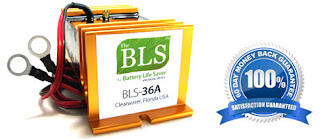There is a new trend; people are looking back to alternative modes of transportation. Gas prices are constantly fluctuating but in general keep going up. People are starting to see that transportation that depends on oil is not going to solve our problems. Sales of bicycles, golf cars and scooters are going up. Sales of big gas guzzling cars are down.
Let’s take a closer look. Will golf carts help with the energy crisis or are they a fad that will go away?
Today golf cars are more popular than ever. Since their introduction in 1951 many changes have occurred. Golf carts can come with all sorts of accessories, sometimes sporting the brands and looks of big luxury cars, their cost range from $1500 to $5000 and up to $30.000 and more for the luxury models but in general their pricing is accessible for the average household.
To Order your BLS (Battery Life Saver) please visit our website at: http://buybls.com
To begin we are going to correct the misnomer of “cart”, per standard z130.1 of American National Standards Institute (ANSI), "carts" are not self-propelled. The official name will then be “golf car” or “buggy”.
Most of golf cars operate with a lead–acid battery system that range from 36 to 72 volts. Their average speed is around 23 mph. A golf car is generally used by golfers for the 18 holes run (6500-7000 yards) but they can run up to 40 miles per charge.
There are many communities around the country where golf cars are used to go to the supermarket, drugstore, church and to do errands. Golf cars are compact and easy to drive and park. The Villages in Central Florida is a great example of a golf car community. It is a dynamic retirement community designed with golf cars in mind. You can see golf cars on every corner and every household has at least one. The cost to fully charge a golf car goes from about $0.40 to a less than a dollar per day depending on the system’s voltage and the condition of the batteries.
So far so good, golf cars are environment and user friendly, relatively inexpensive and energy efficient.
What is the downside?
Very few towns are golf car friendly, making golf car travel more difficult. Most towns have minimum speed limits that are above golf car speed and require turn signals, tail and head lights.
For many friends of speed, well, golf cars do not give them that rush. You can only use golf cars inside your community.
There is a real problem. On talking to some golf car owners we run one by one onto the same problem. After a couple of years the golf car slows down. All the sudden you find yourself “pushing” your car to make it back home.
Behind this terrible problem is usually battery failure. Although made to last 5-10 years, batteries tend to die prematurely because of sulfate buildup. Sulfate is a normal byproduct of the chemical reaction that happens inside lead-acid batteries. Every time the battery is charged and discharged more of those crystals are deposited on the plates. Like layers of fine snow on a garden they accumulate until you can not longer see the garden.
These crystals interfere with the flow of electricity in and out the battery. Batteries will take longer to charge and the charge will last less time.
A good performance for a set of batteries in conditions like Florida, Texas, Nevada, California or Arizona last about 3 years. Then the owners have to experience slow downs until it is unbearable. At that point golf car owners have to go through the “painful” experience of replacing batteries, a $600-$800 expense.
The solution
Towns are going to have to embrace change and learn to accommodate the new street users. Modification of golf cars to comply with current requirements is not very expensive. In any case, residential areas should not have vehicles moving above 25 mph. There are going to be more and more people using bikes, golf cars, scooters and small electric cars. This trend is not going away any time soon.
Now, regarding the huge problem with battery life, here are simple things you can do to maintain and extend the life of your batteries:
1) Regularly charge your car. As much as possible keep your golf cars fully charged. Make sure your charger is a smart charger that will recognize when batteries are fully charged, it protects them from overcharging. Overcharging is deadly to your batteries.
It is an effective way to kill batteries prematurely.
2) Try as much as you can to park your golf car in a shaded area as heat tends to exacerbate the sulfate accumulation.
3) Regularly check the water level on your batteries. Use only distilled water to replenish them.
4) Use a desulfator to control the accumulation of lead sulfate. The Battery Life Saver™ electronic device is the most effective desulfator in the market. It targets the sulfate crystals, breaking them down and rejuvenating the battery. Using this device will extend the life of batteries two to three times, making golf cars a good business for all.
To Order your BLS (Battery Life Save) please visit our website at: http://buybls.com
There is a bright future for golf cars. They can help us to save lots of money and help break the dependency on oil.
To Order your BLS (Battery Life Saver) please visit our website at: http://buybls.com









